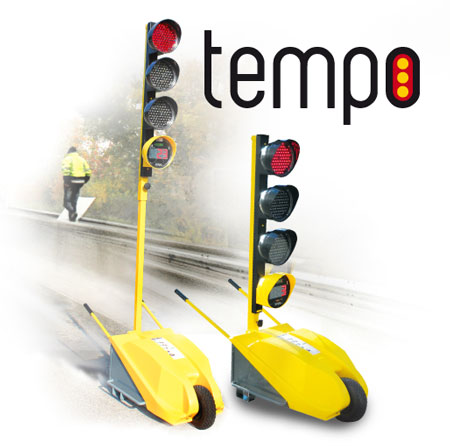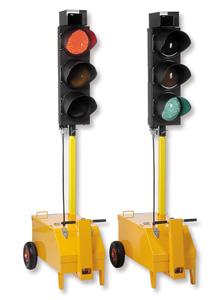Queueing at the traffic lights
My colleague came into the department, fuming. He lived outside Exeter, and commuted by car along one of the main routes into the city. Because the city is divided by the river, there was no alternative route for his daily journey. And there were road works on the road. His frustration was the setting of the temporary traffic lights, which controlled a section of the road where there was one-way traffic. Over coffee, mid morning, we analysed the symptoms and tried to diagnose the underlying problem, and worked towards a solution. I think it became an undergraduate discussion topic - we wanted the students to think about the topics they were learning about.
At each end of the one-way section, there was a set of traffic lights, which used radar to detect the presence of a car waiting. But, he explained, the traffic flowing into the city in the morning and the traffic flowing out in the evening, would be limited to about 60 seconds' worth of green light, then the vehicles in the opposite direction would be allowed through, and they might have 60 seconds - or less - which would completely clear the queue from that direction, leaving the lengthy queue of commuters (in or out) moving forward in a succession of 60 seconds-worth chunks of traffic. He regularly sat through five or six sets of changes before getting through the one-way section.
It was a problem of queueing and the way that the "server" (traffic light) dealt with the queue. There was clearly a setting on the system which used an algorithm like this:
(A) If the light is red and there is a car waiting, signal that the light should change at the next epoch;
(B) If the light is red and there is no car waiting, signal that the light should stay at red;
(C) If there is a signal to change the light, the next epoch is defined as the first of (i) 60 seconds after the lights last changed; (ii) there is no car waiting at the other end.
There was probably a further rule to change all lights to red if there was no car at either end
These rules led to the queues for commuters and their frustration at seeing the traffic in the opposite direction moving so quickly.
So what could be done about it? The radar did not measure the length of the queue, it only detected the presence of a vehicle at the head of the queue, but common sense would have suggested that the traffic would be unbalanced during the weekday rush hours. So we postulated a variation on (C)(i) to make it 120 seconds during the rush hour for the commuting traffic. (120 seconds arises from a psychological observation about UK drivers - if traffic lights do not change in that length of time, then in this country, drivers start to think that the lights do not work and take risks. As I recall, in other countries, drivers may be more patient or more impatient - there are national variations.)
I don't know whether such rules have been included in the programming of temporary traffic signals; we were using common sense and knowledge of queues and statistics.
Now, several years later, we have a related problem at road works near home. There are temporary lights at a local crossroads, replacing the lights which are out of action for a short time. Once again, the problem is the setting of an algorithm. The lights are radar controlled, and at busy times behave like this:
(#) and (##) are not sensible because the traffic does not need such a time to clear the junction - and that is the wrong setting which results in frustration
The permanent lights use 10 seconds in (*) and 3 or 4 seconds in (#) and (##)
I imagine that the installers would argue that they act with a safety margin - but the excessive safety leads to impatience and annoyance; a little application of queue modelling (and common sense) would improve the road user's lot.
At each end of the one-way section, there was a set of traffic lights, which used radar to detect the presence of a car waiting. But, he explained, the traffic flowing into the city in the morning and the traffic flowing out in the evening, would be limited to about 60 seconds' worth of green light, then the vehicles in the opposite direction would be allowed through, and they might have 60 seconds - or less - which would completely clear the queue from that direction, leaving the lengthy queue of commuters (in or out) moving forward in a succession of 60 seconds-worth chunks of traffic. He regularly sat through five or six sets of changes before getting through the one-way section.
It was a problem of queueing and the way that the "server" (traffic light) dealt with the queue. There was clearly a setting on the system which used an algorithm like this:
(A) If the light is red and there is a car waiting, signal that the light should change at the next epoch;
(B) If the light is red and there is no car waiting, signal that the light should stay at red;
(C) If there is a signal to change the light, the next epoch is defined as the first of (i) 60 seconds after the lights last changed; (ii) there is no car waiting at the other end.
There was probably a further rule to change all lights to red if there was no car at either end
These rules led to the queues for commuters and their frustration at seeing the traffic in the opposite direction moving so quickly.
So what could be done about it? The radar did not measure the length of the queue, it only detected the presence of a vehicle at the head of the queue, but common sense would have suggested that the traffic would be unbalanced during the weekday rush hours. So we postulated a variation on (C)(i) to make it 120 seconds during the rush hour for the commuting traffic. (120 seconds arises from a psychological observation about UK drivers - if traffic lights do not change in that length of time, then in this country, drivers start to think that the lights do not work and take risks. As I recall, in other countries, drivers may be more patient or more impatient - there are national variations.)
I don't know whether such rules have been included in the programming of temporary traffic signals; we were using common sense and knowledge of queues and statistics.
 |
| French traffic lights - with handles and a wheel |
- green for westbound traffic for 50 seconds or until there are no cars (whichever is first)
- red all round for 12 seconds because the westbound traffic must clear a narrow section (*)
- green for eastbound traffic for 50 seconds or until there are no cars (whichever is first)
- red all round for 12 seconds (#)
- green for both northbound and southbound traffic for 50 seconds or until there are no cars (whichever is first)
- red all round for 12 seconds (##)
(#) and (##) are not sensible because the traffic does not need such a time to clear the junction - and that is the wrong setting which results in frustration
The permanent lights use 10 seconds in (*) and 3 or 4 seconds in (#) and (##)
I imagine that the installers would argue that they act with a safety margin - but the excessive safety leads to impatience and annoyance; a little application of queue modelling (and common sense) would improve the road user's lot.



Frustration with other sorts of queues (notably for elevators) has in some cases been alleviated by taking the queue member's mind off the wait. Perhaps some large screen televisions showing sports matches or something else generally popular and not requiring a sound track would help?
ReplyDeleteI find it interesting. Signal Tower Lights Distributor
ReplyDelete